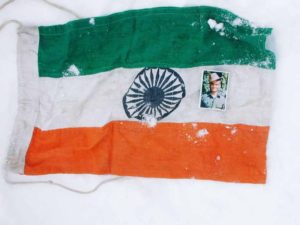The Indian-Japanese East Karakoram Expedition 2002

The Indian Tricolour and the picture of Lt. Nawang Kapadia on the summit of Padmanabh
The expedition consisting of 5 Indian and 5 Japanese mountaineers undertook a long traverse of the Eastern Karakoram valleys for two months and achieved a lot. The team covered almost 550 km (with various repeated load-ferries), carried almost 2500 kg of food, equipment and personal gear (first on 55 mules, later by personal ferries by 11 members and 15 Sherpas and porters) and lived continuously on snow for almost 35 days, braving rather cold temperatures.
The team traversed a historic route in the Shyok valley and returned via the Nubra valley (the Siachen glacier). Five passes were reached or crossed, two large glaciers were fully traversed and a vast unknown ice plateau was explored. Above all, the first ascent of a virgin and difficult 7030 m high peak of Padmanabh was achieved.
- The team traversed the Shyok river valley from the Shyok village (Tankse – Darbuk) to Karakoram Pass, along the ancient winter Trade route – the first expedition to achieve this in last five decades.
- Historic Karakoram Pass, on the international border between Indian and China was reached. First time in history of independent India that a team involving foreign mountaineers was permitted to visit the Pass. (One sole British photographer had reached the pass in 1997). Japanese mountaineers were the first from their country to stand on the pass after 93 years.
- The team traversed the entire Central Rimo Glacier and the Teram Shehr Glacier by crossing Col Italia, the high pass between the two glaciers. It was for the first time, since its first crossing in 1929, that this pass was crossed – after 73 years. (An Indian team consisting of almost same members had reached the pass in 2000, but had not crossed it).
- The high and vast Teram Shehr Ice-Plateau was explored and various cols surrounding the Plateau were investigated. The Plateau is a unique feature in the Karakoram with ice and snow at height of about 6200 m, surrounded by high peaks on all sides. This was for the first time that anyone had reached the plateau (Harish Kapadia and Ryuji Hayashibara), seen so often in photos taken from peaks like Rimo.
- The first ascent of peak Padmanabh (7030 m) was made on 25th June 2002 (Hiroshi Sakai and Yasushi Tanahashi) After setting up a second Base Camp (5650 m) at its foot another high summit camp was made at 6250 m near a col at foot of the south ridge. In next four days, 16 pitches of ropes were fixed till about 6750 m. Two teams consisting of Japanese and Indian mountaineers worked together to push the route. Finally a team of 2 Japanese and one Indian (Lt Cdr S. Dam) started for the summit. However Dam had to drop out of the final attempt soon. Two Japanese in a long push of almost 11 hours of continuous climbing reached the summit. Both had previously climbed Nanga Parbat but rated this peak more difficult in many aspects than that famous “Killer mountain”. A team of Indians and Japanese (Motup Chewang, Rushad Nanavatty and Dr Oe (each of them had worked hard and reached high in preparing the final route) was poised to attempt the summit again in next two days but due to onset of bad weather for next few days plans had to be given up.
- This was the highest peak on the Teram Shehr Plateau and a major first ascent in the Siachen Glacier group after many years.
- The team returned via the Siachen Glacier to the Nubra valley. This was the first international team to climb on this war-torn glacier since 1986. These were the first Japanese mountaineers to visit the glacier from the Indian side since the conflict on the Siachen Glacier began in 1984 (many Japanese teams had climbed on the Siachen Glacier between 1972-1983, approaching it from the west).
Despite gathering war clouds between India and Pakistan while the expedition was on the mountains, the Indian army fully backed the team and at no point we were asked to stop or change route.
The expedition
The expedition is grateful to the Indian Army for permission and support to undertake this venture. We are specially thankful to Lt. General R. K. Nanavatty, PVSM, UYSM, AVSM, General Officer Commanding – in – Command, Northern Command, Indian Army, without whose strong support we would not have been able to climb in this area or complete the expedition under difficult situation that developed.
Full detailed report about the expedition is available on www.harishkapadia.com.


